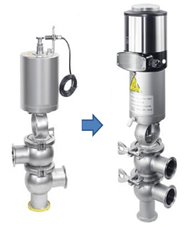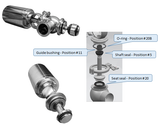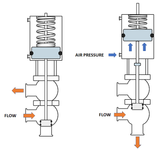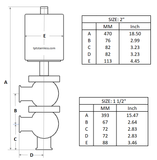Tri-Clamp Sanitary Divert Valve
Pazzini 900 Series
Application:
The single-seat divert valve is a hygienic pneumatically operated valve used for flow diversion in the food, beverage, and pharmaceutical processing industry.
Features:
• Made in SS316L / wetted surfaces
• Few moving parts, contributing to high reliability and low maintenance.
• Easy cleaning
• Seat gasket replacement in less than 7 minutes without removing the valve from the line and no tools required.
• Repairable actuator

Spare parts
Materials:
• Product wetted steel parts: AISI 316L (internal Ra < 0.8 μm)
• Other parts in stainless Steel: AISI 304
• Plug gasket: EPDM
• Other product wetted seals EPDM (standard)
Technical specifications:
• Max working pressure: 145 psi (10 bar)
• Min. working pressure: Full vacuum
• Working temperature: Please see below information.
Working Principle:
Seat valves are operated by a single-acting, double-acting pneumatic actuator or manual handle. The compressed air is applied to the actuator and the shaft is moved to place the valve in the "open" or "closed" position.
Single seat divert valves have one seal for each switching position separating the particular pipelines from one another. The single-seat divert valves are not recommended for separating incompatible fluids.
Recommended Inlet:
|
Position 1 Non-actuated (Rest Position) |
Position 2 Actuated (Working position) |

Easy Conversion / Integration:
The 180º rotation of the pneumatic cylinder of the single-acting actuators allows having a normally open or normally closed valve.

Our design allows for easy integration from a simple and economical solution using an inductive proximity sensor to a control head that includes the electro-valve and the sensors, both used to control and supervise the pneumatic valve.

Flow Capacity:
The flow coefficient Cv is the volume (in US gallons) of water at 60 °F that will flow per minute through a valve with a pressure drop of 1 psi across the valve.
|
Position 1 |
Position 2 | ||
| Valve size | CV | Valve size |
CV |
| 1 1/2" | 24 | 1 1/2" | 35 |
| 2" | 54 | 2" | 70 |
| 3" | 139 | 3" | 190 |
Other pressure drops than 1 psi the flow can be calculated with the following formula:
Q= Cv x √ ∆p
Where:
Q= Flow in GPM
Cv = Flow coefficient.
∆p = Pressure drop in psi over the valve.
Example:
1 1/2" valve has a Cv= 35 GPM with a pressure drop of 1 psi.
For a pressure drop of 2 psi which is the flow?
Q= 35 X √2 = 49 GPM.
Fluids other than water, please consult us.
Static seal temperatures
| Gasket Properties | EPDM | VITON |
| Heat resistant | Excellent (275°F) | Excellent (400°F) |
| Cold resistant | Good-Excellent (-20°F) | Good-Excellent (-30°F) |
| Steam | Good | Excellent |
| Abrasion-resistant | Good-Excellent | Good |
| Alkali | Good | Poor-Good |
| Acid resistance | Good-Excellent | Good |
| Vegetable oil | Good | Excellent |
| Petroleum oil | Poor | Excellent |
| Oxonia | Good-Excellent | Excellent |
| Ozone | Good-Excellent |
Excellent |
Note: .
| Recommended temperature for short periods of time (15-20 min) | EPDM: 260°F, VITON: 285°F | ||
| Recommended temperature for short periods of time (15-20 min) | EPDM: 260°F, VITON: 285°F | ||
DIMENSIONS

PRESSURE DATA:
When the pressure at the inlet port "product pressure" builds enough to overcome spring pressure a leakage at the valve seat can occur. See below the table for product pressure recommended.
|
|
|||||||||||||
|
|










